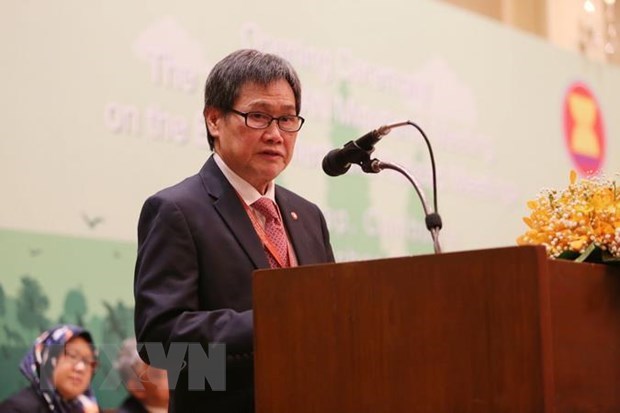 |
|
ASEAN Secretary-General Dato Lim Jock Hoi (Photo: VNA)
|
In a written interview with the Vietnam News Agency (VNA)’s correspondent in Jakarta, Lim said during Vietnam’s holding of ASEAN Chairmanship in 1998, 2010, and 2020, Hanoi readily displayed able and decisive leadership in steering the region towards undertaking important priorities. One example is the Mid-Term Review (MTR) of the implementation of ASEAN Community 2025 Blueprints currently being conducted. This is pivotal in assessing the progress and challenges, while addressing the implementation gaps of the three pillars. Another example is RCEP (Regional Comprehensive Economic Partnership) which is the ASEAN-driven trade pact deemed as the largest global trade agreement comprising all key Asian economies.
The ASEAN Secretary-General stressed that Vietnam has further raised the bloc’s international profile in the past 25 years. For example, as Vietnam officially began its term as President of the United Nations Security Council (UNSC) as part of its stint as a non-permanent UNSC member for 2020-2021 term, Hanoi has set out priorities with issues that it considers of significance and where it can also play an important role, including, among others, climate change, and coordination between the UN and ASEAN.
Economically, Vietnam has proactively reached out to the global market by signing numerous trade agreements – both bilaterally and multilaterally – with different partners. Two latest examples would be CPTPP (Comprehensive and Progressive Agreement for Trans-Pacific Partnership), and European Union (EU)-Vietnam Free Trade Agreement and EU-Vietnam Investment Protection Agreement.
There is no doubt that Vietnam has successfully integrated itself to the ASEAN family, since its joining. According to a PwC study, Vietnam’s GDP will be among the world’s top 20 by 2050, in purchasing power parity (PPP) terms. Its economic success, political stability and visionary leadership, coupled with the vibrant energy of its people, are assets to the ASEAN Community building.
Given its geographical location, Vietnam plays an important role in taking the lead in strengthening linkages between ASEAN mainland and the rest of the region, in particular on global emerging issues like climate change, biodiversity, marine debris, agriculture, and sustainable environment, especially along the Mekong sub-region.
Regarding Vietnam’s ASEAN Chairmanship, Lim noted that 2020 started off as an important year for ASEAN. While COVID-19 has slightly derailed some of its events and initiatives, ASEAN has stayed focused in undertaking important milestone exercises, as the region demonstrates commitment in its integration journey. The MTR of the implementation of ASEAN Community 2025 Blueprints and RCEP are examples.
Of course, the foremost challenge now is for the region to continue to work closely together in overcoming the COVID-19 pandemic with swiftness, openness and cohesiveness. In this regard, Vietnam has done extremely well in initiating practical measures to tackle this issue, especially in addressing the socio-economic impacts of COVID-19. Working in close collaboration with Thailand, Vietnam has led the establishing of the COVID-19 ASEAN Response Fund. ASEAN would also launch a Regional Reserve for Medical Supplies, and Standard Operating Procedure (SOP) on Public Health Emergencies.
Other priorities include laying the groundwork to prepare ASEAN in adapting to and thriving in the era of Industrial 4.0, including bridging the digital divide, and working towards a more sustainable, inclusive, and resilient economy and society.
While evaluating ASEAN’s achievements, values and identities, the Secretary-General said that on the whole, ASEAN has done well in its 53 years of integration journey. Various mechanisms of cooperation have been continued to be put in place under the respective sectors within its political-security, economic, and socio-cultural spheres of its Community building process between ASEAN and its external partners.
Since its inception in 1967, ASEAN has successfully provided and maintained peace, prosperity and security in the region, thereby allowing each member state to undertake national cum economic development, and to thrive and integrate within the region and into the global economy. With the closer market integration, it was able to build and create an “investor-friendly” business environment. Today, ASEAN finds itself to be the 5th largest global economy and 3rd most attractive international investment destination. It is also the world’s 4th largest trading region.
As ASEAN becomes more economically-competitive, it brings better employment opportunities to its 680 million populace. With better jobs, it leads to raising living standards and alleviating poverty of the ASEAN people. With higher income, it led to the expansion of the middle class, with families having more disposable income, and the youth receiving better access to education. This further led to greater people-to-to-people movements in the region, e.g. tourism, students-exchange, and youth volunteerism/internships. These developments resulted in an enhanced and conducive environment for us to undertake broader awareness-raising and deeper identity-building, as we promote “ASEAN: A Community of Opportunities for All”.
On the bloc’s future stature, the ASEAN chief said the emergence of Asia is indeed exciting times, and ASEAN is well-positioned to showcase the prospects of the so-called “Asian century”.
As a start, an ASEAN with enhanced political cohesion, economic integration and social responsibility, will continue to work with likeminded nations and states towards a dynamic, inclusive and open global community where prosperity and responsibility for peace and security are shared by all.
Within the grouping, ASEAN would maintain and strive to be a responsible, open, rules-based, and globally connected player that actively participates in global value chains and supply-chain connectivity. ASEAN would also continuously strengthen its cooperation mechanisms and resources to be agile and resilient in addressing future challenges. In doing so, ASEAN would be ready to seize the opportunities in the evolving regional and global environment./.VNA